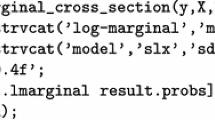Abstract
This paper extends the matrix exponential spatial specification to panel data models. The matrix exponential spatial panel specification produces estimates and inferences comparable to those from conventional spatial panel models, but has computational advantages. We present maximum likelihood approach to the estimation of this spatial model specification and compare the results with the fixed effects spatial autoregressive panel model.

Similar content being viewed by others
Notes
It is assumed spatial weight matrix to be constant through time.
Notice \(\mathbf{q}\) is symmetric.
Extensively approached in Baltagi (2008).
Where \(\mathbf{j}_p\) is a vector of \(1\)’s and \(p\) is the dimension of \(\varvec{\beta }\).
References
Anselin L (1988) Spatial econometrics: methods and models. Kluwer Academic Publishers, Dordrecht
Baltagi BH (2008) Econometric analysis of panel data, 4th edn. Wiley, London
Elhorst P (2003) Specification and estimation of spatial panel data models. Int Reg Sci Rev 26:244–268
Haining R (2004) Spatial data analysis: theory and practice. Cambridge University Press, Cambridge
Horn R, Johnson C (1988) Matrix analysis. Cambridge University Press, Cambridge
Hsiao C (2003) Analysis of panel data, 2nd edn. Cambridge University Press, Cambridge
Kapoor M, Kelejian H, Prucha I (2007) Panel data models with spatially correlated error components. J Econ 140:97–130
Kelejian H, Prucha I (2002) A generalized moments estimator for the autoregressive parameter in a spatial model. Int Econ Rev 40(2):509–533
LeSage JP, Pace K (2007) A matrix exponential spatial specification. J Econ 140:190–214
Ord J (1975) Estimation methods for models of spatial interaction. J Am Stat Assoc 70:120–126
Silva AR, Alves PF (2007) Computational algorithm for estimation of panel data models with two fixed effects. Braz J Math Stat 25(2):19–32
Author information
Authors and Affiliations
Corresponding author
Appendix
Appendix
1.1 The FESAR estimation
Usually, \(\mathbf{X}\) has a vector of \(1\)’s for estimating the intercept. The fixed effect \(\mathbf{c}\) is restricted so that \(\mathbf{j}_N ' \mathbf{c}=0\). Thus, the interpretation of the fixed effect \(c_i\) is the difference between the \(i\)th observation mean and the overall mean.
In practice, using the within transformation, the presence of intercept does not make any difference because all effects constants through time are dropped. Therefore, the model (1) can be rewritten as
The likelihood function of the FESAR model considering the within transformation is
Fixing \(\varvec{\beta }\) and \(\sigma ^2\), we can find the likelihood function only for \(\rho \). Thus, let \(\tilde{\varvec{\beta }}=(\mathbf{X'QX})^{-1}\mathbf{X'Qy}\) and \(\tilde{\sigma }^2=\frac{1}{ NT }\mathbf{y'S'PSy}\), where \(\mathbf{P}\) is the orthogonal projections matrix given by \(\mathbf{P} = \mathbf{I}_{ NT } - \mathbf{QX}(\mathbf{X'QX})^{-1}\mathbf{X'Q}\). Therefore, the likelihood for \(\rho \) is given by:
Note that \(\mathbf{I}_{ NT }-\rho (\mathbf{I}_T\otimes \mathbf{W})=\mathbf{I}_T \otimes (\mathbf{I}_N-\rho \mathbf{W})\), and therefore, \(|\mathbf{S}|=| \mathbf{I}_{T}\otimes (\mathbf{I}_N-\rho \mathbf{W}) | = | \mathbf{I}_N - \rho \mathbf{W}|^T \). So, we can write (14) as
Using eigenvalues, (15) can be written as
where \(\omega _i\) is the \(i\)th eigenvalue of the matrix \(\mathbf{W}\).
Note that
because
Consequently, the likelihood for \(\rho \) is
So \(\rho \) can be estimated by an iterative Newton-Raphson process as
where
If it is desirable to estimate the model with two fixed effects, then the matrix \(\mathbf{Q}\) is replaced by
and the estimation procedure is the same as of the one-way fixed effect.
1.2 Properties of the MESPS maximum likelihood estimators
Let the likelihood of the model \(\mathbf{Sy}=\mathbf{X}\varvec{\beta }+\varvec{\epsilon }\) be
once \(|\mathbf{S}|=1\) and \(\varvec{\theta }=(\varvec{\beta }, \gamma ,\alpha )\).
Let, for instance, \(H(\varvec{\theta })=- l (\mathbf{y},\varvec{\theta })\) and \(G(\varvec{\theta })=\frac{\partial }{\partial \varvec{\theta }} H(\varvec{\theta })\). In a first-order Taylor series context, it is reasonable to write
Evaluating \(\varvec{\theta }\) at \(\hat{\varvec{\theta }}_{ML}\) and if \( o \) is a neglectable error, then \(G(\hat{\varvec{\theta }}_{ML})=G(\varvec{\theta }_0 )+\frac{\partial }{\partial \varvec{\theta }}G(\varvec{\theta }_0)(\hat{\varvec{\theta }}_{ML} -\varvec{\theta }_0) \).
Notice that \(G(\hat{\varvec{\theta }}_{ML})=0\) because that is the optimality first condition.
Rewriting \(G(\hat{\varvec{\theta }}_{ML})=G(\varvec{\theta }_0 )+\frac{\partial }{\partial \varvec{\theta }}G(\varvec{\theta }_0)(\hat{\varvec{\theta }}_{ML} -\varvec{\theta }_0) \), we have
And \( I (\varvec{\theta })=\left( - \frac{\partial ^2}{\partial \varvec{\theta } \partial \varvec{\theta }'} l (\mathbf{y},\varvec{\theta })\right) ^{-1}\) is the Fisher information matrix. Rearranging,
Notice that \( l (\mathbf{y},\varvec{\theta })=\sum _{i=1}^{ NT } \log \; f(y_i)\) and \(E \left[ \frac{\partial }{\partial \varvec{\theta }}\log \;f(y_i) \right] =0\) because
and
The Central Limit Theorem may be used in the sense that
Rights and permissions
About this article
Cite this article
Figueiredo, C., da Silva, A.R. A matrix exponential spatial specification approach to panel data models. Empir Econ 49, 115–129 (2015). https://doi.org/10.1007/s00181-014-0862-2
Received:
Accepted:
Published:
Issue Date:
DOI: https://doi.org/10.1007/s00181-014-0862-2




